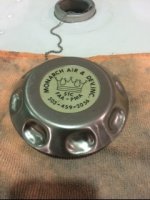Wingwrench
Registered User
Lakeland, Fl
I swapped out 2 on a customers airplane several years ago at oshkosh. I went by their booth and told them what was going on and they swapped them out, I got the impression they knew there was an issue. It looked like they did thread down far enough.
I have the original machined aluminum Monarch caps on my airplane and they have never leaked a drop since '90.
I have the original machined aluminum Monarch caps on my airplane and they have never leaked a drop since '90.











